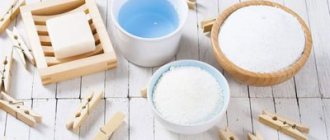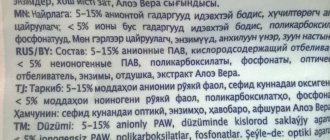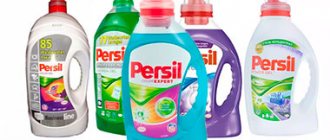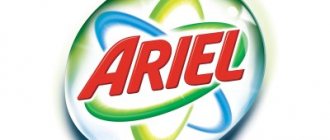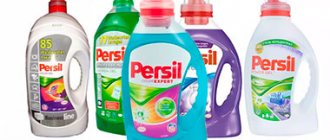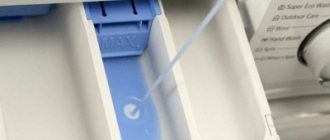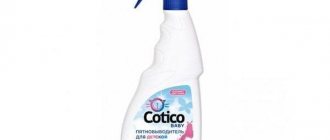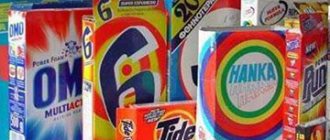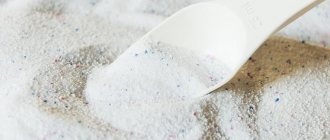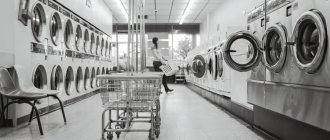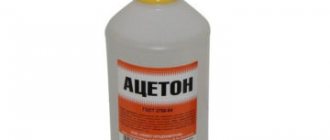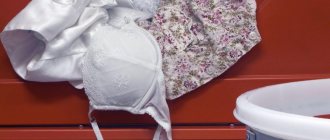In the household chemicals market, the lion's share of shelves is occupied by ordinary washing products: powders, capsules and liquid gels, and only a small part of the shelves is occupied by eco-chemicals. Such products have not received widespread advertising, which is why many buyers bypass them, choosing the usual ones.
Why fall victim to advertising and the harmful effects of harmful chemicals? If you know the composition of the washing powder, you can choose the safest one for washing clothes. Next, we'll look at what chemical and natural products are made from so you can make an informed choice.
Composition of conventional and natural washing powders
Before drawing conclusions and choosing any type of powders and detergents, you should understand its composition and see the difference. You can make eco-friendly laundry detergent yourself!
Conventional laundry detergents consist of a number of chemicals:
- Anionic surfactants are responsible for the formation of thick foam, removing stains and greasy dirt. According to standards, the content of A-surfactants should not exceed 2-5%, since these substances can negatively affect health by penetrating the body through the skin and settling on internal organs;
- Non-ionic surfactants - act deep in the tissues. They are easily washed off with water, decompose into safe elements and are non-toxic to human health. The consistency of non-ionic surfactants is liquid or paste-like, therefore they are used in powders extremely rarely;
- Oxygen bleaches - remove plaque from fabrics, whiten, disinfect and eliminate unpleasant odors. The most commonly used is sodium percarbonate, which decomposes into soda ash and oxygen. Safe for humans;
- Phosphonates - necessary to soften hard water. Presented in the form of esters and salts. They became a replacement for phosphate, as they are non-toxic;
- Polycarboxylate is a carbon-based compound that also softens water and protects the machine from corrosion;
- Zeolites are absorbents that destroy dirt. Phosphonates help soften water. Natural ziolites are safe for health, but synthetic ones are just as toxic as phosphates;
- Enzymes are compounds that destroy protein contaminants. Used when washing up to 40 degrees. They have a level of moderate toxicity and can cause dermatitis. Destructive effect on things made of natural wool;
- Optical brighteners are organic compounds that absorb ultraviolet rays and impart a blue color to fabrics to enhance whiteness. Unsafe because they do not wash off and can cause skin irritation;
- Flavoring additives - mask the smell of the chemical elements of the powder and add freshness. Often cause irritation of mucous membranes and skin;
- Sodium tripolyphosphate is a phosphate used to make cheap powders. Toxic;
- Sodium hypochloride is also an ingredient in low-quality powders. This is a chlorine bleach that increases the toxicity of surfactants and phosphates;
- Cationic surfactants are amine salts that have a bactericidal effect and neutralize the toxicity of anionic surfactants. Added only to high-quality and expensive powders;
- TAED - activators of oxygen bleaches. Not always mentioned in the composition;
- Anti-resorbents - protect fabrics from dirt adhesion during washing;
- Phthalates - do not allow the smell of fragrances to erode and keep laundry fragrant and fresh.
Manufacturers of natural powders strive to make them as safe as possible, so many harmful and toxic substances have been replaced with organic substitutes:
- Biological surfactants replace anionic and non-ionic substances. These can be fatty alcohols, palm or coconut oil, potato, wheat, glucose compounds;
- Auxiliary and non-ionic surfactants act as bleaches;
- Sodium disilicate is a safe replacement for phosphates. It is recommended to use powders with a sodium disilicate content of at least 20%;
- Stabilizer of peroxide compounds - used instead of chlorine and optical brighteners;
- Essential oils are added to give laundry a pleasant aroma after washing.
Differences in “hand wash” and “machine wash” components
Powders for automatic washing differ in composition from preparations for manual processing. Their main feature is less foam formation. For this purpose, defoamers are introduced into them, which allow for effective washing with a minimum amount of foam.
Also, many powders marked “Automatic” contain substances that serve to prevent the deposition of limescale on machine elements in contact with water and the washing mixture. But not all manufacturers of detergents introduce such an addition. Detailed information can be found on the packaging of the drug.
The introduction of additional ingredients into the composition of powders for automatic processing leads to an increase in the cost of products. This article will tell you how powders for hand washing differ from automatic ones.
Dry
To prepare dry powders, dry laundry soap, grated on a fine grater, is used. All necessary components are mixed, at the last stage a few drops of essential oils are added, mixed and placed in an airtight container.
Recipe 1:
- 150 g dark laundry soap;
- 500 g regular soda;
- 400 g soda ash;
- essential oil.
Whitening Powder Recipe:
- 1.5 cups of laundry soap;
- 1 cup soda ash;
- 0.5 cups baking soda;
- 1 cup borax;
- a few drops of aromatic oils.
Recipe 3:
- 2 pieces of crushed laundry soap;
- 1 cup baking soda;
- 1 cup soda ash;
- 2 tablespoons of vinegar (3 or 9 -%);
- essential oils (essential to eliminate the strong smell of vinegar).
Enemy of our body No. 4 - Flavors
Fragrances are very often an integral part of washing powders. Those who make powders temptingly promise us the smells of “white rose”, “blooming lilac” and attention - AROMATHERAPY. But we must know - artificial flavors are a 100% petroleum product that has an absolutely negative effect on our body. Most often these are allergic manifestations in the form of irritation of the mucous membranes, burning in the nose, and it would be very stupid to inhale these flavors while enjoying aromatherapy.
Liquid
To prepare liquid laundry detergent, you will need a saucepan and water.:
- Grate 1 piece of laundry soap, place it on the bottom of the pan, cover with water and cook over medium heat until smooth;
- add water to half the pan, add 1 cup of soda ash, 0.5 cup of borax, stir;
- add water and leave to cool overnight with the lid closed;
- Add essential oil to the cooled mixture.
Using such powders is quite simple. The product is added to the drum of the machine or to a special compartment for powder, at the rate of 1-2 tablespoons per 2-3 kg of items.
Test 1
Persil Gold Plus, in comparison with its predecessor Persil Gold, when washed in the “cotton 30°C” program, showed significantly better washing ability against the following stains applied to 100% cotton textiles:
- chocolate drink (CFT CS-44).
- cherry juice (B&J)
- chocolate ice cream 1 (Asda)
- chocolate ice cream 2 (Carte D'or)
- chocolate ice cream 3 (Vienetta)
- raspberry juice (Del Monte)
- chocolate milkshake (Frij)
- raspberry ice cream (Tesco)
Best Organic Powder Manufacturers
Amway SA8 Premium
Liquid concentrated detergent. It copes well with stubborn stains, preserves the color of linen, and is completely washed out of fabrics.
Frau Marta
Concentrated powder of German quality. Manufacturers guarantee that 2 kg of product replaces 6 kg of regular powder. The composition contains oxygen bleach and bioadditives responsible for removing stains. Safe and certified product.
Faberlic
Faberlic presents a series of concentrated liquid powders - for dark and colored fabrics, special fabrics and white linen. When creating the product, a biodegradable formula is used. The composition is safe and non-toxic.
Faberlic products not only cope well with various contaminants, but also protect the skin of your hands and are also very economical to use.
Nature Clean
Nature Clean is a Canadian brand that produces certified non-toxic and hypoallergenic laundry and cleaning products . The company presents dry powders and liquid gels containing soda ash and sodium chloride, herbal surfactants, salts and non-toxic minerals. Products from Nature Clean are economical and easy to use. The linen does not lose shape and color, and acquires a pleasant aroma.
Chistown
Washing powders from Chistown are made on the basis of natural soap. They are completely biodegradable, do not damage the washing machine, do not clog pipes, and are produced in environmentally friendly paper bags.
Baby Line
Baby Line soft gel is designed for washing baby clothes. Gently cleans things without leaving marks on the fabric. Made from natural ingredients that are safe for child health and the environment. Has a bactericidal effect.
IVF2
Bleach and soap bombs for washing EKO2 are no less popular and of high quality. The products are made using active oxygen, which breaks down into harmless elements - water, soda and oxygen.
The products rinse well in water, leave no residue, and disinfect laundry and water. Suitable for washing in any water.
GOST
All detergents are produced in accordance with standards and specified norms. One of the main regulatory documents is GOST.
, substances whose occurrence is more than 0.2% of the following components
are mandatory for inclusion in the information on packaging
- Surfactant
- Phosphates and phosphonates.
- Polycarboxylates.
- Zeolites.
- Soap.
- Oxygen-containing bleaches.
- Some types of acids and salts.
The manufacturer must indicate the percentage of components, taking into account the range:
- 30% or more;
- from 15 to 30%%
- from 5 to 15%;
- up to 5%.
also be indicated in the composition (regardless of the mass fraction):
- optical brighteners;
- disinfectant components;
- enzymes;
- preservatives;
- fragrance
Compliance with GOST requirements is mandatory for manufacturers. Find out more here.
Children's natural remedies
Among the organic powders for washing children's clothes are:
- Sodasan Comfort Sensitive is a powder containing silicates, polyaspartates and citrates, suitable for all types of fabrics, does not cause allergies, and prevents the appearance of scale and corrosion. The product is used very economically;
- Garden kids Eco-friendly - contains silver ions, due to which it has a bactericidal effect. Ideal for children with sensitive skin and asthma sufferers. Completely decomposes and does not harm health;
- Burti Hygiene - removes stubborn stains, allergens and germs. Whitens things well;
- Tobbi Kids is a washing powder based on natural soap. Available for different ages of children;
- Babyline Baby Powdered Detergent is a concentrated detergent for washing baby clothes. Made from soap and active oxygen. Harmless and economical;
What conclusions can be drawn from the above:
- Popular washing powders are approximately the same in composition, including those for children and for sensitive skin.
- All of them contain harmful chemical compounds that can accumulate in the body.
- They are absolutely unacceptable for washing children's clothes.
- The state and corporations really don’t care about our health. And what? Well, if the consumers themselves spit on it... In Russia, GOST allows something that in the civilized world has long been recognized as poison and excluded from formulations.
- You should abandon popular detergents in favor of special eco-powders. True, not everything is so obvious there either, because you can simply write ECO on a box with a pesticide))
- Whatever one may say, you and I will still have to memorize the names of dangerous components, because every manufacturer is happy to fool us. And so that boring chemical terms do not disappear from your head, here is a reminder for you:
If you want to print a reminder, . You can print a maximum of 20x20 cm without loss of quality.
And now I suggest you read my reviews of truly safe products from the Pure Water (Russia) and Sonett (Germany) brands, which I have personally tested.
If chemists, ecologists and just those who are in the know read me, I will gladly accept your additions and comments on the topic!
Organic fabric conditioner
When washing, conditioners are often used to soften fabrics. We present to our attention organic conditioners:
- Vernel - products are developed on the basis of cationic surfactants that are safe for the environment;
- Lenor - environmentally friendly conditioners that soften fabrics, add freshness and antistatic properties, and increase the wear resistance of things;
- Eared Nian - a product containing extracts of lavender, aloe and cashmere, suitable for both adults and children;
- Cotico - conditioners soften things, preserve color and quality, are hypoallergenic and safe. Gives laundry a pleasant aroma;
DIY cooking
You can prepare eco-friendly fabric softener at home:
- before washing, add 100 ml of vinegar and a few drops of essential oil to the conditioner compartment;
- mix 1 liter of water, 140 ml of vinegar, 0.5 cups of baking soda. Mix everything and add 120-140 ml when washing;
- Mix 600 ml of water with 300 ml of vinegar and 200 ml of natural hair balm and mix. use 150 ml per wash.
Popular articles
- Using natural face cream: advantages and disadvantages, DIY preparation Our skin needs constant care to maintain it in a blooming state. And there’s no way around it...
- Making natural soap with your own hands at home It’s no secret that natural handmade soap is better than regular store-bought soap. But the reasons why...
- Making natural shower gel: how to make your own products for adults and children, top best brands For daily body care, especially after a hard day at work, you want to choose a natural product with…
WATER:
- moisturizes the fabric
- dissolves washing powder
- washes away and removes dirt
- conducts heat
Not everything is new - just a remake of the old
In order not to lose in competition, commodity producers are faced with the need to introduce a new product to the market as often as possible.
It is in the “News” segment that the frontline of the struggle for the consumer lies, to whom you always serve something fresh. Technological progress, however, does not keep pace with the unbridled desire of the manufacturer to constantly amaze its consumer with something new. You can’t get enough new products in such quantity, and manipulations with “re-facing” are used: not newly created products are presented as such by cleverly giving them a new face, image. And it passes! The deception, in general, is not great, but it is a deception! So, without a twinge of conscience, a product that has been on the market for a long time is passed off as “revolutionary new”, but... with a slightly changed name, in new packaging, and, naturally, at a new price! We are, of course, not just talking about washing powders. This technique is “Everything new is just a remake of the old!” – universal in marketing. Cosmetic “rejuvenation” of products that set the teeth on edge is presented as a change in the model range with a corresponding increase in price. But in reality it turns out that a familiar and cheaper product from 2-3 years ago is no worse than such a “super new product”. Washing powders belong to that category of products in which it is especially difficult to surprise with something fundamentally new, since they all consist of a set of the same components. Nothing fundamentally different has yet been invented. But there is a need for continuous improvement of quality. Manufacturers of detergents, constantly improving their quality, thereby respond to improving the quality of those products, the use of which leads to contamination of clothes and other items. The more high-quality, durable paints, hair dyes and other potential contaminants in our clothes become, the greater the cleaning power of washing powders. Such dialectics! When children drew with slate pencils, there was no need for detergents, which are now indispensable with the advent of felt-tip pens, markers, etc. Products that use strong dyes are becoming a growing problem. Today you can paint fences with other drinks (alcoholic and non-alcoholic)! An increase in cleaning power is achieved by creating a more successful composition with the introduction of additional types of enzymes, ensuring increased chemical purity of the components and special care of their mixing. This becomes possible as a result of scientific research and the introduction of high technologies.
Let's talk about tests confirming the high quality of detergents, using the example of cooperation in this direction with the Henkel company, which produces the world-famous Persil.
Persil vs Persil. Comparative tests
demonstrating respect for its consumer not in words, but in deeds, it was one of the first to begin prefacing the advertising campaign of its new products with tests in Rostest-Moscow, which should confirm the authenticity of the declared properties and qualities. The startup began testing the Persil “POWER PERSIL” AUTOMAT synthetic detergent produced by a new (at that time) formula in comparison with its own product of the previous generation. The task was to obtain documentary evidence that the new product actually has more effective cleaning power. Coffee and tea, wine and juice, grass, chocolate, dirt, hamburger grease, cosmetics, carrots, tomatoes, oil... According to statistics, it is precisely this type of pollution that we most often annoyingly stain our things with. It is clear that leading manufacturers of synthetic detergents compete primarily in removing precisely this type of stain. The comparative testing program for the new product and the prototype included 20 test cycles for 15 stains in two temperature conditions - “Cotton 40°” and “Cotton 60°”. Processing of the obtained data using the Fisher test stated that the new synthetic detergent Persil “POWER PERSIL” AUTOMAT is characterized by a higher cleaning ability: for six contaminants the new product showed a “higher” result in comparison with the synthetic detergent produced previously, and for nine - even “ much higher":
- coffee (much higher)
- tea (much higher)
- black currant (much higher)
- blueberry juice (much higher)
- young red wine (above)
- grass (much higher)
- chocolate (much higher)
- tomato puree (above)
- blood (above)
- grass and dirt (much higher)
- carrots + mashed potatoes (above)
- red wine (much higher)
- pigment + oil (above)
- cosmetics (much higher)
- colored olive oil (above)
For those who prefer handmade
For those who prefer washing by hand (as they say, “in a basin”), we present the results of comparative tests of a synthetic detergent of a new formula for hand washing SMS “Persil for hand washing (hand wash)” with a previously produced product. For six contaminations, the new product showed “higher” results, and for five - “significantly higher”:
- coffee (above)
- tea (much higher)
- black currant (much higher)
- blueberry juice (much higher)
- grass (above)
- chocolate (much higher)
- tomato puree (above)
- blood (much higher)
- carrots + mashed potatoes (above)
- cosmetics (above)
- hamburger fat (above)
So if, unfortunately, one of the above stains appears on your things, this is not yet a reason to be seriously upset: to regain the lost cleanliness, you don’t even need to bother with the washing machine. In this case, it is enough to have a basin on hand and an SMS message “Persil for hand wash”
PERSIL v. COMPETITOR
At the next stage, the task was posed more acutely: the experts were asked, as they say, to compare PERSIL GOLD, which had just appeared then, with the best analogue available on the Russian market.
Self-assessment of products based on comparison with analogues is provided for by most quality assessment models, but enterprises are extremely reluctant to do it. Competitors often prefer not to notice each other point-blank, preferring in advertising campaigns to risklessly compare their products with some abstract, hypothetical (even such a definition has appeared!) analogue, slyly called “ordinary”. Perhaps this is the first time that a manufacturer has offered to conduct an independent examination of the quality of its products in comparison with a truly real and strongest analogue on the market. The goal was by no means to “put down” a competitor and build their PR on such anti-advertising - this would contradict the ethics of this kind of comparative testing. Therefore, what kind of powder was used for comparison was not made public. But experts guaranteed that this was not some hypothetical analog convenient for comparison, but a very real competitor of the same class, “weight category” and price range. The CMC Persil Gold sample, in comparison with the analog sample when washed in automatic drum-type washing machines on the “cotton 60°C” program, after processing the results according to the Fisher test, showed significantly better washing ability for the following contaminants: Textile base “Cotton”:
- red paint for painting.
Textile base “Mixed composition (polyester 65% and cotton 35%)”:
- rust
- markers (orange, pink)
- hair dye (chestnut N3, medium blond N6, silver blond C10, black N1)
- paint for painting (red, green).
Textile base "Polyester":
- rust,
- markers (orange, pink, green)
- hair dye (fire red R15, dark chestnut N2, chestnut N3, medium blond N6, pearl blonde A10, silver blonde C10, black N1)
- paint for painting (yellow, red, green),
- coffee (CFT BC-2),
- tea (CFT VS-3),
- black currant (CFT CS-12),
- blueberry juice (СFT CS-15),
- red wine (CFT CS-103),
- chocolate drink (CFT CS-44).
What standard gold PERSIL
Among the “experimental” detergents was PERSIL GOLD PLUS powder.
Its fundamental feature is that it is environmentally friendly - it does not contain phosphates, which are replaced by a special modified system of components that effectively work against hardness salts and at the same time dissolve in water without any problems. Before releasing a new environmentally friendly product onto the market, the manufacturer decided to answer, as they say, the question that naturally arises among consumers: will it be worse in cleaning ability than its predecessor, albeit less environmentally friendly? The question, frankly speaking, is a burning one. In theory and in words, we are all sincerely for the environment! Under one condition, however: if it doesn’t cost us anything personally! If you need to take an extra step to get to the ballot box, the piece of paper ends up on the sidewalk. And if the most environmentally friendly powder turns out to be not as “washing” and less economical than a non-ecological one, then it will simply become uncompetitive. This, unfortunately, is the logic of the market. In short, consumers should be confident that by switching to an environmentally friendly detergent, they will not lose in the quality of their laundry. In order not to be unfounded in promising statements, the Henkel company proposed to Rostest-Moscow to conduct an examination of the general cleaning ability of the powder of the ecological formulation PERSIL GOLD PLUS and, based on its results, confirm or refute the manufacturer’s claim that it is functionally not inferior to phosphate-containing products. Tests have shown: PERSIL GOLD PLUS of the phosphate-free formulation is not inferior to either its predecessor or the strongest analogues (its name is not disclosed, as required by professional ethics).
